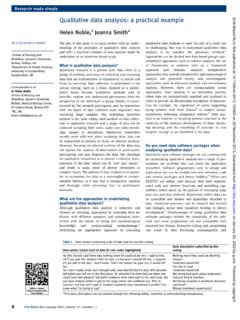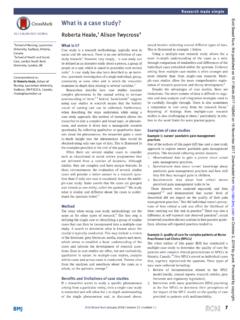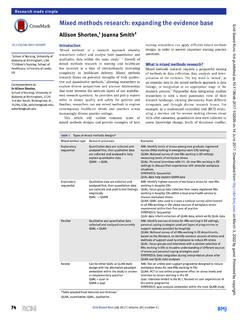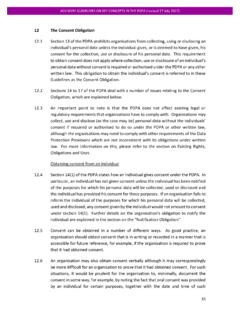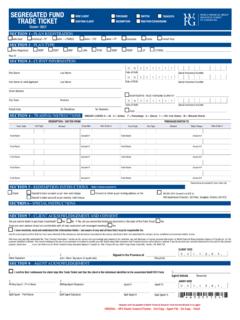Transcription of Data collection in qualitative research
1 research made simple data collection in qualitative research Evid Based Nurs: first published as on 1 June 2018. Downloaded from on January 12, 2022 by guest. Protected by copyright. David Barrett,1 Alison Twycross2. qualitative research methods allow us to better under- An example of a semistructured interview schedule stand the experiences of patients and carers; they for a study exploring surgeons' perceptions of post- 1. allow us to explore how decisions are made and operative pain3 can be seen in box 1. An interview Faculty of Health Sciences, provide us with a detailed insight into how interven- schedule such as this is normally developed prior to University of Hull, Hull, UK.
2 2. School of Health and Social tions may alter care. To develop such insights, qual- the start of the study following an extensive review of Care, London South Bank itative research requires data which are holistic, rich the literature and often also draws on the researcher's University, London, UK and nuanced, allowing themes and findings to emerge clinical experience. Before data collection commences, through careful analysis. This article provides an over- the interview schedule is often reviewed by a small view of the core approaches to data collection in qual- group of subject experts to ensure all key issues have Correspondence to: itative research , exploring their strengths, weaknesses been included.
3 Dr David Barrett, Faculty of and challenges. Interviews present several challenges to researchers. Health Sciences, University Most interviews are recorded and will need transcribing of Hull, Hull HU6 7RX, UK; D. I.. before analysing. This can be extremely time-con- Barrett@ hull. k Interviews suming, with 1 hour of interview requiring 5 6 hours to Collecting data through interviews with participants is The analysis itself is also time-consuming, a characteristic of many qualitative studies. Interviews requiring transcriptions to be pored over word-for-word give the most direct and straightforward approach to and line-by-line. Interviews also present the problem of gathering detailed and rich data regarding a particular bias the researcher needs to take care to avoid leading phenomenon.
4 The type of interview used to collect data questions or providing non-verbal signals that might can be tailored to the research question, the character- influence the responses of participants. istics of participants and the preferred approach of the researcher. Interviews are most often carried out face- to-face, though the use of telephone interviews to over- Focus groups come geographical barriers to participant recruitment is The focus group is a method of data collection in which becoming more a moderator/facilitator (usually a coresearcher) speaks The key variation between interview types relates to with a group of 6 12 participants about issues related to the degree of structure.
5 An open or unstructured inter- the research question. As an approach, the focus group view will often be based on a single question, with the offers qualitative researchers an efficient method of interviewer and interviewee then shaping the conver- gathering the views of many participants at one time. sation in real time, rather than following a prewritten Also, the fact that many people are discussing the same schedule. This can be particularly suited to methods in issue together can result in an enhanced level of debate, which participants are being encouraged to tell a story with the moderator often able to step back and let the of their life or experiences, such as narrative enquiry.
6 Focus group enter into a free-flowing This An example of the type of study in which these open, provides an opportunity to gather rich data from a conversational interviews are well suited was an explo- specific population about a particular area of interest, ration of the impact of time on the work of Registered such as barriers perceived by student nurses when trying to communicate with patients with A common approach in qualitative research is the From a participant perspective, the focus group may semistructured interview, where core elements of the provide a more relaxing environment than a one-to-one phenomenon being studied are explicitly asked about interview; they will not need to be involved with every by the interviewer.
7 A well-designed semistructured part of the discussion and may feel more comfortable interview should ensure data are captured in key areas expressing views when they are shared by others in the while still allowing flexibility for participants to bring group. Focus groups also allow participants to bounce'. their own personality and perspective to the discussion. ideas off each other which sometimes results in different Finally, interviews can be much more rigidly structured perspectives emerging from the discussion. However, to provide greater control for the researcher, essentially focus groups are not without their difficulties. As with becoming questionnaires where responses are verbal interviews, focus groups provide a vast amount of data rather than written.
8 To be transcribed and analysed, with discussions often Deciding where to place an interview design on this lasting 1 2 hours. Moderators also need to be highly structural spectrum' will depend on the question to be skilled to ensure that the discussion can flow while answered and the skills of the researcher. A very struc- remaining focused and that all participants are encour- tured approach is easy to administer and analyse but may aged to speak, while ensuring that no individuals domi- not allow the participant to express themselves fully. At nate the the other end of the spectrum, an open approach allows for freedom and flexibility, but requires the researcher to Observation walk an investigative tightrope that maintains the focus Participant and non-participant observation are of an interview without forcing participants into partic- powerful tools for collecting qualitative data , as they ular areas of discussion.
9 Give nurse researchers an opportunity to capture a wide Evid Based Nurs July 2018 | volume 21 | number 3 | 63. research made simple Conclusion Box 1 Example of an interview schedule3. Evid Based Nurs: first published as on 1 June 2018. Downloaded from on January 12, 2022 by guest. Protected by copyright. The three core approaches to data collection in quali- tative research interviews, focus groups and observa- What do you think is the most effective way tion provide researchers with rich and deep insights. of assessing a child's pain? All methods require skill on the part of the researcher, Have you come across any issues that make and all produce a large amount of raw data .
10 However, it difficult to assess a child's pain? with careful and systematic analysis12 the data yielded What pain-relieving interventions do you with these methods will allow researchers to develop a find most useful and why? detailed understanding of patient experiences and the When managing pain in children what is work of nurses. your overall aim? Whose responsibility is pain management? Competing interests None declared. What involvement do you think parents should have in their child's pain Patient consent Not required. management? Provenance and peer review Commissioned; internally What involvement do children have in their peer reviewed. pain management?

